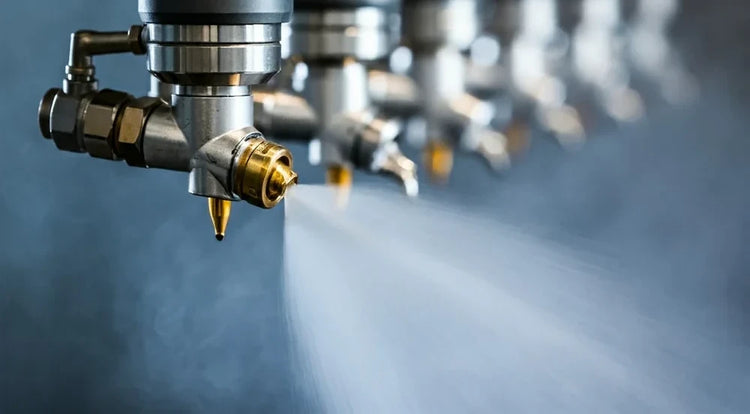Lubrication Spray Nozzles for Metalworking & Steel Mills
Precision lubricant application for machining, forming, stamping, forging, and rolling—reduce friction, control heat, prevent tool wear, and extend equipment life while minimizing lubricant consumption up to 60%.
Lubrication plays a critical role across metalworking and steel mill operations—reducing friction between tool and workpiece, controlling heat generation, preventing adhesive and abrasive wear, and ensuring smooth production of high-quality metal products. Inadequate lubrication results in premature tool failure, excessive energy consumption, poor surface finish, dimensional inaccuracies, and unplanned equipment downtime that disrupts production schedules and increases operating costs.
NozzlePro delivers engineered spray lubrication systems that precisely apply cutting fluids, stamping lubricants, forging compounds, and rolling mill emulsions exactly where needed—optimizing film thickness, maximizing lubricity, and minimizing waste. Our application-specific nozzles support operations from high-speed machining centers processing aluminum aerospace components to heavy plate mills rolling 50mm steel plate, delivering consistent performance across oil-based, water-based, synthetic, and semi-synthetic metalworking fluids.
Critical Metalworking Lubrication Applications
🔧 CNC Machining & Cutting
Precision coolant/lubricant delivery for turning, milling, drilling, and grinding operations. High-pressure through-tool systems (5–70 bar) deliver cutting fluid directly to tool-chip interface, reducing cutting temperatures 200–400°C, extending tool life 2–5×, and achieving superior surface finishes (Ra 0.4–3.2 µm) on ferrous and non-ferrous materials.
Machining Lubrication →⚙️ Stamping & Forming Operations
Controlled lubricant application for progressive dies, transfer presses, and deep drawing operations. Precision spray patterns ensure uniform die coating, prevent galling and pickup, reduce forming forces 15–40%, and eliminate part defects (scoring, orange peel, wrinkles) on steel, aluminum, and stainless steel stampings running at 60–1,200 strokes per minute.
Stamping Lubrication →🔨 Forging & Hot Working
High-temperature lubricant/release agent application for open-die forging, closed-die forging, and upset forging operations. Spray systems apply graphite-based compounds, water-based lubricants, or synthetic release agents to dies operating at 150–350°C, preventing sticking, reducing die wear, and extending die life from 5,000 to 20,000+ impressions.
Forging Lubrication →🏭 Rolling Mill Operations
Roll cooling and lubrication emulsion systems for hot strip mills, cold rolling mills, and temper mills. Combined spray/emulsion delivery provides boundary lubrication (reducing friction coefficient 0.3 to 0.05–0.15), controls roll temperature, prevents roll fire cracking, and achieves target strip surface finish (0.2–2.5 µm Ra) for automotive, appliance, and tinplate applications.
Roll Lubrication →📏 Drawing & Extrusion
Wire drawing, tube drawing, and extrusion die lubrication systems. Uniform lubricant films reduce drawing forces, prevent die scoring, control surface finish, and minimize lubricant carryover. Systems support wet drawing (soap solutions), dry drawing (powder coatings), and aluminum extrusion (graphite/oil compounds) at speeds up to 30 meters per second.
Drawing Lubrication →⚡ Minimum Quantity Lubrication (MQL)
Near-dry machining systems delivering micro-droplets (1–100 ml/hour) of lubricant suspended in compressed air. MQL technology reduces lubricant consumption 90–95% versus flood cooling, eliminates coolant disposal costs, improves chip evacuation, and achieves comparable or superior tool life in milling, drilling, and turning of aluminum, cast iron, and steel alloys.
MQL Systems →Performance Benefits of Precision Lubrication
- Extended Tool Life – Optimized lubrication reduces cutting tool wear 50–80%, stamping die wear 40–70%, and extends service intervals from hundreds to thousands of parts per tool.
- Reduced Friction & Energy – Boundary lubrication films reduce friction coefficients from 0.3–0.5 (dry) to 0.05–0.15 (lubricated), lowering motor loads, reducing energy consumption 10–30%, and decreasing heat generation.
- Improved Surface Quality – Consistent lubricant application prevents scratching, galling, adhesive pickup, and built-up edge formation—achieving superior surface finishes (Ra 0.2–3.2 µm) and eliminating costly secondary finishing operations.
- Dimensional Accuracy – Thermal control and friction reduction maintain tight tolerances (±0.01–0.05mm) throughout production runs, reducing scrap rates and rework requirements.
- Higher Production Speeds – Effective lubrication enables 20–50% faster cutting speeds, forming rates, and throughput without compromising quality or tool life.
- Lubricant Cost Reduction – Precision application reduces lubricant consumption 40–60% versus flood application, with MQL systems achieving 90–95% reductions while maintaining equivalent performance.
- Environmental Compliance – Reduced lubricant usage minimizes waste disposal volumes, lowers VOC emissions, and simplifies regulatory compliance with EPA, OSHA, and local environmental regulations.
- Cleaner Operations – Targeted application reduces mist generation, minimizes floor contamination, improves workplace safety, and lowers facility cleaning and maintenance requirements.
Engineering Precision Lubrication Systems
Application-Specific Parameters
| Application | Nozzle Type | Pressure Range | Flow Rate | Shop Collection |
|---|---|---|---|---|
| High-Speed Machining | Through-tool / Air-atomizing | 5–70 bar | 0.05–2 L/min per spindle | Air-Atomizing |
| MQL (Minimum Quantity) | Air-atomizing micro-spray | 4–6 bar air | 0.01–0.1 L/hour per tool | Air-Atomizing |
| Stamping & Deep Drawing | Flat fan / Full cone | 2–10 bar | 0.1–5 L/min per station | Flat Fan |
| Forging Die Lubrication | Full cone / Air-atomizing | 3–15 bar | 0.2–3 L/min per die | Full Cone |
| Cold Rolling Mills | Flat fan emulsion headers | 5–40 bar | 10–200 L/min per stand | Flat Fan |
| Wire & Tube Drawing | Fine spray / Hollow cone | 2–8 bar | 0.05–1 L/min per die | Hollow Cone |
| Grinding Operations | Flood / Full cone | 1–20 bar | 0.5–20 L/min per wheel | Full Cone |
Custom Engineering: Final system specifications depend on workpiece material, process speeds, lubricant type, surface finish requirements, and environmental constraints. Request a lubrication analysis and we'll provide detailed spray layouts, flow calculations, and ROI projections including tool life improvement, lubricant savings, and energy reduction for your specific application.
Metalworking Fluid Compatibility
Oil-Based Lubricants
Straight cutting oils, chlorinated oils, and sulfurized oils for heavy-duty machining, gear cutting, and broaching. High lubricity, extreme-pressure protection, and excellent rust prevention. Typical dilutions: neat to 5:1 water/oil. Applications: turning hardened steel, threading operations, deep hole drilling.
Water-Based Emulsions
Soluble oils and emulsifiable fluids providing balanced cooling and lubrication. Excellent heat removal, moderate lubricity, economical operation. Typical dilutions: 10:1 to 30:1 water/oil. Applications: general machining, stamping, rolling mills, grinding operations.
Synthetic & Semi-Synthetic Fluids
Chemical lubricants providing superior cooling, extended sump life, and reduced biological growth. Low-mist formulations improve air quality. Typical dilutions: 15:1 to 40:1 water/concentrate. Applications: high-speed machining, aluminum cutting, automated manufacturing cells.
Specialty Compounds
Graphite suspensions, PTFE dispersions, and solid film lubricants for extreme conditions. Forging release agents, die lubricants, and drawing compounds formulated for specific high-temperature or high-pressure applications requiring EP (extreme pressure) additives.
Related Steel & Metal Solutions
🔥 Steel Cooling
🔧 Descaling
🎨 Coating

